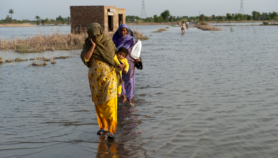09/05/19
Climate now biggest driver of migration, study finds

By: Inga Vesper
Send to a friend
The details you provide on this page will not be used to send unsolicited email, and will not be sold to a 3rd party. See privacy policy.
The effects of climate change, including floods and extreme temperatures, have become more important push factors in migration than economic inequality or conflict, according to a global study.
The study, undertaken by a team at the University of Otago in New Zealand, looked at migration data from 198 countries of origin to 16 member states of the Organization for Economic Cooperation and Development (OECD) between 1980 and 2015.
Researchers developed a model to understand the causes of migration, divided into effects of climate change, economic performance and political strife.
“Both developed and at-risk countries need more planning and policy to prepare for what is likely to be a growing trend of people wanting to move”
Dennis Wesselbaum, economist, Otago Business School
The model showed that rising temperatures and a growing number of weather-related disasters now cause more migration than lack of income or political freedom.
Each 10 per cent increase in temperature in an origin country caused an increase of 3 per cent in migration from that country to the 16 destination countries, which included Australia, Italy, Spain and Germany.
The study, published last month in the journal Global and Planetary Change, also found that this migration happens in stages.
Dennis Wesselbaum, the lead researcher and an economist at the Otago Business School, explains that migration actually decreased for around five years after a temperature anomaly, before increasing for the next 20 years.
“One explanation is that people move to places further away and have to save more money to finance migration cost, [or] that it takes time to identify the temperature shock,” Wesselbaum told SciDev.Net.
Raya Muttarak, senior lecturer of geography and international development at the UK’s University of East Anglia, believes another reason for the apparent delay is that people at first try “in-situ adaptation”.
“If you experience climatic shocks in the first year, you try different ways to cope, such as planting different crops, changing jobs, borrowing money,” said Muttarak, who was not involved in the study. “You’re probably not trying to move straight away.”
The researchers found that global temperatures increased by an average of 0.8 degrees Celsius in the study period. They counted 100 weather-related disasters in 1980, but by 2015 this number had risen to 300 a year.
Around 244 million people – 2.8 per cent of the world’s population – were classed as migrants in 2015 by the UN. However, the UN has said it will not define climate migrants as refugees, a status that comes with more international support, citing concerns about watering down support programmes for those fleeing violent conflict.
A report by the UNFCC, the UN’s climate change body, found last year that, globally, countries are largely failing to deal with climate migration adequately.
“Recognising the causal factors behind this forced migration would require governments to apportion responsibility, both for the initial migration and for the solutions to it,” said Steve Trent, director of the Environmental Justice Foundation, which lobbies on environmental issues in the Global South. “In many countries this is politically toxic and, without international agreement on shared and coordinated action, proves politically very hard to deal with.”
Wesselbaum is confident, however, that the problem will be recognised “sooner or later”, adding that the results of his study offer a more nuanced understanding of how people respond to climate shocks.The climate migration model showed that migration remained stable after storms and drought, but increased significantly after floods and extreme temperature events.
“Both developed and at-risk countries need more planning and policy to prepare for what is likely to be a growing trend of people wanting to move,” Wesselbaum added.













